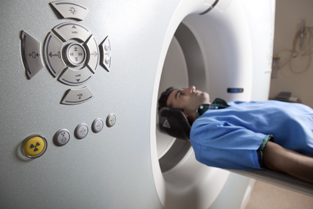
Promoting Safe Use of MRI Technology
Promoting the Safe Use of MRI Technology
An ASTM standard from Committee F04 on Medical and Surgical Materials and Devices describes a marking system for medical devices in the magnetic resonance environment.
Magnetic resonance imaging technology made its debut in the healthcare industry in the 1980s. MR scanners use magnetic signals to create images of the human body, helping physicians to study nerves, muscles, ligaments, bones and other tissues, and to diagnose injuries and disease. A popular procedure in the treatment and care of athletes, MR scans have dramatically grown in use among the general patient population as well. According to the American College of Radiology, the usage of MR scanners in the United States has more than doubled since 1995. Today, MR scans are one of the more common imaging technologies used to view the inside of the body. Recent industry data shows that approximately 26 million MR procedures are performed each year.1
Within the MR environment, potential safety hazards pose concern for patients, MR technologists and other medical professionals. Implants such as pacemakers and metal joint replacements can interact with the MR scanner's magnets and pulses, and can result in device damage, malfunction and overheating that may lead to serious patient injury and death. There is also the risk of projectile accidents caused when other medical devices and metallic items are pulled into the bore of the MR system.
Responding to the growing use of MR technology and a number of reported safety incidents, the U.S. Food and Drug Administration recognized the need for standards that address MR-related safety issues for implants and other medical devices. To best achieve consensus across stakeholders, including medical device manufacturers, patients, healthcare facilities and professionals, and the regulatory community, the FDA requested that a new standards activity be organized within ASTM International.
F2503: FDA-Recognized Standard for MR Safety Terms and Markings
Working in ASTM Committee F04 on Medical and Surgical Materials and Devices, stakeholders came together in an MR task group to develop F2503, Practice for Marking Medical Devices and Other Items for Safety in the Magnetic Resonance Environment.
Recognized in FDA guidance, F2503 provides a uniform marking system to indicate what MR conditions have been determined to be acceptable for a medical device or other item. It provides MR labeling terms and associated visual icons intended to reduce injuries when potentially hazardous items are brought into the MR environment.
F2503 mitigates technologist confusion and facilitates patient safety in the MR environment by defining clear terminology for marking medical devices and other items in the MR environment:
- MR Safe - used for items that are nonconducting, nonmetallic and nonmagnetic, such as a plastic Petri dish, and pose no known hazards in all MR environments.
- MR Conditional - used for an item that has been demonstrated to pose no known hazards in a specified MR environment with specified conditions of use. Conditions that define the MR environment include static magnetic field strength, radio frequency fields, specific absorption rate and other factors. For MR conditional items, the item labeling includes results of testing sufficient to characterize the behavior of the item in the MR environment.
- MR Unsafe - defines an item that is known to pose hazards in all MRI environments, such as a pair of ferromagnetic scissors.
To facilitate use of this marking methodology, F2503 references other F04 standards to help test and characterize the behavior of items in an MR environment. Among these are F2052, Test Method for Measurement of Magnetically Induced Displacement Force on Medical Devices in the Magnetic Resonance Environment; F2119, Test Method for Evaluation of MR Image Artifacts from Passive Implants; and F2182, Test Method for Measurement of Radio Frequency Induced Heating on or Near Passive Implants During Magnetic Resonance Imaging.
Labeling Guidelines Aid Product Manufacturers
Each safety-related term defined in F2503 has a corresponding marking icon, consistent with international standards for colors and shapes of safety signs. For implants, the standard specifies that the MR marking should be included in the package labeling, including the instructions for use and package inserts, as well as on the patient information card. For nonimplanted items intended to be used in the MR environment, F2503 defines that the marking should be positioned in a prominent location and in the item labeling.
Facilitating a Safer MR Environment
While it is impossible to eliminate all risk in the MR environment, ASTM F2503 provides a valuable utility so that patients, manufacturers, regulatory bodies and healthcare professionals can work together to enhance safety in the MR environment:
- Through clear and consistent safety information on implant devices, patients are more informed about potential MR-related hazards, enabling enhanced self-advocacy.
- Relying on an industry consensus standard, the FDA can guide manufacturers on the inclusion of MR safety information in both new and existing products, promoting overall public health.
- With improved product labeling, medical device manufacturers can better ensure the safe use of their products in the MR environment.
- Using F2503, clinicians, nurses, technologists and other medical professionals gain increased awareness of potential MR safety risks, facilitating the delivery of improved patient communications and care delivery.
"MR scans are becoming more and more ubiquitous in the healthcare environment," says Terry Woods, Ph.D., laboratory leader in the Office of Science and Engineering Laboratories at FDA and an F04 member. "F2503 recommends uniform, scientifically proven methods for product testing, along with a common labeling platform that regulators, manufacturers and medical professionals can rely upon to better protect public health and safety."
Reference
1. American College of Radiology, Utilization of Imaging, www.acr.org.
Doug Clauson is a freelance writer based in Wynnewood, Pa.
 SN Home
SN Home Archive
Archive Advertisers
Advertisers Masthead
Masthead RateCard
RateCard Subscribe
Subscribe Email Editor
Email Editor